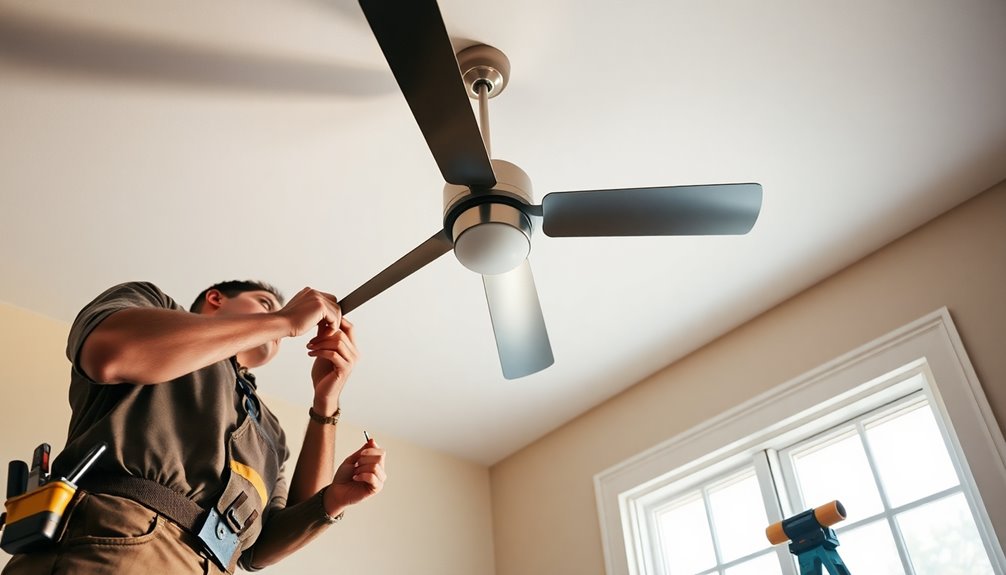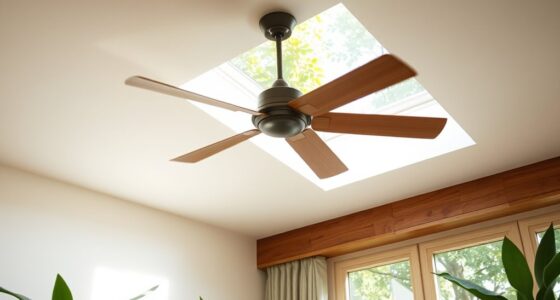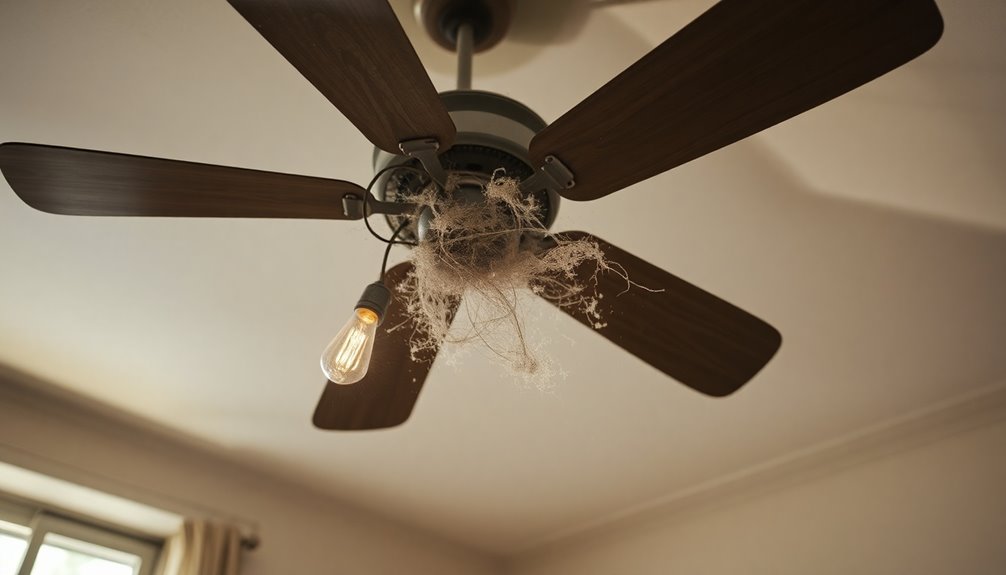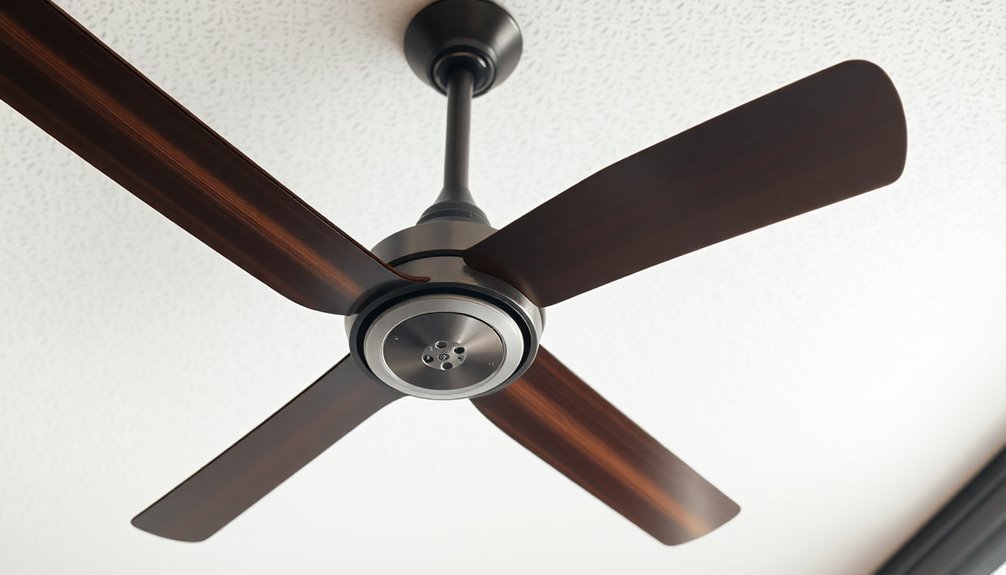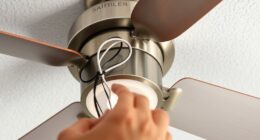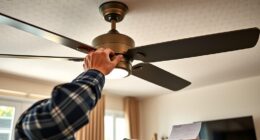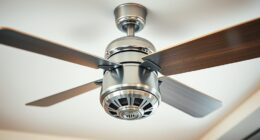Getting a ceiling fan installed usually costs between $100 and $300. This price can vary based on factors like the type of fan you choose and whether you have existing wiring. If you need new wiring, costs can jump to $2,000 or more. Hiring a licensed electrician can add around $150 for the first hour, with additional charges thereafter. If you prefer a DIY approach, you could save a bit, but make sure you're comfortable with electrical work. Curious about additional factors that might affect your installation costs? There's more to reflect on!
Key Takeaways
- Average installation costs range from $100 to $300, typically around $249 with existing wiring.
- New wiring installation can significantly increase costs, reaching up to $2,000 if needed.
- Labor costs vary, with licensed electricians charging $150 for the first hour and $50 to $130 thereafter.
- Basic installations usually take 1-2 hours, while complex setups may require 3-4 hours of labor.
- Additional features like smart switches or angled mounts can increase overall installation costs.
Installation Cost Overview

When considering ceiling fan installation, it's essential to understand the costs involved. The average cost for ceiling fan installation ranges from $100 to $300, typically landing around $249.
Installation costs can vary greatly based on factors like the complexity of the job and existing wiring. If you don't have existing wiring, costs could soar up to $2,000.
For basic ceiling fan installation with existing wiring, expect to pay between $100 and $500. If you're opting for a fan and light combo, budget an extra $100 to $300.
The cost of labor plays a big role here, usually ranging from $50 to $200 per hour. Electricians may charge about $150 for the first hour, with additional hourly rates following that.
If you're thinking about installing multiple fans at once, you might save on overall costs since travel fees and hourly rates could be lower.
Understanding these elements can help you prepare for your ceiling fan installation costs, ensuring you make informed decisions that fit your budget.
Labor Costs and DIY Options

Labor costs for ceiling fan installation can considerably impact your overall budget, typically ranging from $50 to $200 per hour. If you hire a licensed electrician, you might pay around $150 for the first hour, with subsequent hours costing between $50 and $130.
For simpler installations, employing a handyperson can save you money, as their rates average between $50 and $150 per hour.
If you're handy and have basic electrical knowledge, you could consider DIY options to reduce total costs from $100 to $275. However, be cautious; safety is paramount. Installing a ceiling fan requires adherence to safety codes, and without the right tools or experience, you could face risks.
For complex tasks or if you're unsure about any aspect of the installation, it's wise to engage a licensed electrician. They guarantee compliance with safety codes, minimizing potential hazards.
Ultimately, weigh your options carefully—balancing labor costs against the peace of mind that comes from professional installation might just be worth it.
Types of Ceiling Fans

When choosing a ceiling fan, you've got several options that cater to different needs and styles.
From standard ceiling fans that often include light fixtures to specialty variations and energy-efficient models, there's something for every room. Additionally, modern Energy Star certified fans can significantly enhance airflow while contributing to lower energy bills.
Standard Ceiling Fan Options
Standard ceiling fans are a popular choice for homeowners looking to enhance comfort and style in their spaces. They typically range in cost from $50 to $300, making them an affordable option for many. These fans often come with light fixtures, delivering both illumination and air circulation in one unit.
When considering fan installation, it's crucial to factor in both materials and labor. Installation costs can vary widely, averaging between $100 and $500, depending on wiring conditions and complexity.
Here's a quick overview of standard ceiling fan features:
| Feature | Details |
|---|---|
| Size Range | 42-56 inches for rooms up to 350 sq ft |
| Energy Efficiency | Many models are ENERGY STAR-rated |
| Average Fan Cost | $50 – $300 |
| Average Installation Cost | $100 – $500 |
With these options, you can find a standard ceiling fan that fits your needs and budget. By choosing an energy-efficient model, you could save on utility bills over time while enjoying the comfort of a well-placed ceiling fan in your home.
Specialty Fan Variations
Exploring specialty fan variations can open up a world of options tailored to your specific needs and space. Specialty ceiling fans come in various types, each designed for unique settings.
For instance, low-profile fans are perfect for rooms with ceilings under 8 feet, with installation costs ranging from $200 to $650 due to their compact design. If you have high ceilings, hanging propeller fans, which typically cost between $300 and $900 to install, feature a more complex design that accommodates those heights.
Directional fans allow you to adjust airflow, with installation costs starting around $300, depending on the specific features.
On the higher end, rotational fans, known for their dual motor options, can be quite expensive, with installation costs from $350 to $1,850 due to their advanced mechanics.
Outdoor fans, designed to withstand the elements and often wet-rated, vary widely in installation costs—from $250 to $3,000—based on complexity and features.
Energy-Efficient Fan Choices
Choosing the right ceiling fan can considerably impact your home's energy efficiency, especially if you opt for models rated ENERGY STAR. These energy-efficient fans use less energy than standard ceiling fans, helping you save money on electricity bills over time.
When considering ceiling fan installation cost, low-profile ceiling fans are ideal for rooms with ceilings under 8 feet. Priced between $200 and $650, they guarantee efficient air circulation in tight spaces.
Standard ceiling fans also range from $200 to $650 and can include light fixtures, making them a versatile option for your home.
For larger spaces, directional fans, starting at $300, allow you to adjust airflow, maximizing comfort while minimizing energy consumption.
If you're looking to enhance your outdoor areas, outdoor ceiling fans are designed to withstand the elements and provide energy-efficient cooling solutions, with prices ranging from $250 to $3,000. Additionally, selecting the right fan can lead to significant energy savings throughout the year, ultimately enhancing your home's overall efficiency.
Additional Accessories and Considerations

When enhancing your ceiling fan installation, considering additional accessories can greatly improve functionality and style.
For instance, if you're installing on a sloped ceiling, an angled ceiling mount priced between $20 and $50 is essential for proper operation. You might also want to add smart fan switch kits, which allow app connectivity and range from $30 to $100, making it easy to control fan speed remotely.
Pull chains are another inexpensive upgrade, costing between $5 and $15 each, adding a decorative touch while providing easy access to control your ceiling fan.
If you're planning a ceiling fan replacement or installing multiple fans, doing so simultaneously can lead to reduced hourly labor rates, considerably impacting your average cost to install.
Finally, consider blade covers, which improve air quality and run between $20 and $35 each.
These additional accessories not only enhance your ceiling fan's performance but also elevate its overall aesthetic. By thoughtfully choosing these options, you can create a more comfortable and stylish environment in your home.
Cost-Saving Tips

Enhancing your ceiling fan installation with accessories can certainly add value, but there are also plenty of ways to cut costs during the process. Here are some cost-saving tips to help you lower costs while improving your home:
| Strategy | Potential Savings |
|---|---|
| Install multiple fans simultaneously | Lowers hourly rates |
| Choose locations near existing wiring | Keep costs $100-$300 |
| Hire a handyperson for basic installs | Save $50-$200 |
| Purchase fans off-season | Get better discounts |
When you decide to install your ceiling fan, consider the DIY vs. hiring a pro debate. If you can utilize existing wiring, a handyperson may be all you need. This can save you a good chunk of change. Plus, investing in ENERGY STAR-rated fans will guarantee energy efficiency, leading to lower utility bills in the long run. Keep these tips in mind as you navigate your ceiling fan installation, and you'll enjoy both improved comfort and cost savings in your home improvement project.
Wiring Considerations

When you're considering ceiling fan installation, the condition of your existing wiring plays a big role in your overall costs.
If your current wiring is compatible, you might keep expenses between $100 and $300, but new wiring could push costs up to $2,000.
It's important to assess whether your ceiling box can support the fan and if any upgrades are needed to guarantee safety and functionality.
Existing Wiring Impact
Before you start your ceiling fan installation, it's important to take into account the existing wiring in your home, as it can greatly influence both the cost and complexity of the project.
If you have suitable existing wiring, installation costs typically range from $100 to $300. Basic installations using this wiring can often be completed in just 1-2 hours, while complex installations may take 3-4 hours, depending on the fan type and ceiling access.
One key factor is whether your current ceiling box can support the fan. If it can't, you might need to install a fan-rated junction box, which can raise your overall installation prices.
Additionally, the condition and compatibility of your existing wiring with the new ceiling fan are essential for a safe setup. If additional electrical work is necessary, it can further impact your costs.
Before moving forward, assess your existing infrastructure carefully. If your home lacks suitable wiring, you could face installation costs skyrocketing to up to $2,000, making it imperative to evaluate your existing wiring before proceeding with the fan installation. Furthermore, understanding the importance of proper sizing can help ensure that your ceiling fan operates efficiently within your space.
New Wiring Expenses
Installing a ceiling fan without existing wiring can lead to significant expenses, often ranging from $500 to $2,000 depending on factors like ceiling height and access.
When you opt for new wiring, costs typically fall between $500 and $1,500. This price varies based on the complexity of the installation and local labor rates.
To guarantee compliance with safety standards, hiring a licensed electrician is vital for any new wiring installation. They'll assess whether your existing wiring is compatible with the new fan type, which can help avoid additional costs later on.
If your ceiling is particularly high or if you have limited access, expect the project to become a complex installation. This complexity can drive up both labor and material costs, making it essential to get a clear estimate upfront.
Professional vs. DIY Installation

Considering whether to hire a professional or tackle a DIY installation for your ceiling fan can greatly impact both your budget and safety.
Professional installation typically ranges from $100 to $500, with labor costs varying between $50 to $200 per hour based on the complexity of the job. Hiring a licensed electrician is advisable, especially for new wiring, to guarantee compliance with safety codes, although their rates can be between $50 to $130 per hour.
On the other hand, DIY installation can help you save on labor costs, with total expenses generally falling between $100 to $275. However, this route demands a solid understanding of electrical systems to avoid safety issues. If you misstep during the installation, you might incur additional costs for repairs or need to hire a professional to fix the errors.
Basic installations usually take 1-2 hours, while more complex setups can extend to 3-4 hours, influencing your decision.
Ultimately, while DIY can be budget-friendly, professional installation often guarantees safety and compliance, making it a better option for those unsure about their electrical skills.
Installation Timeframes and Benefits

When you factor in installation timeframes, you'll find that basic ceiling fan setups typically take just 1 to 2 hours, while more intricate installations can stretch to 3 to 4 hours.
If you're considering multiple ceiling fans, installing them simultaneously can optimize time and reduce overall labor costs, as the ceiling fan installer can save on travel fees.
Here are some benefits of professional installation:
- Compliance with local electrical codes: Guarantees safety and reduces future issues.
- Energy efficiency: Ceiling fans improve air circulation, leading to significant cost savings on electricity bills.
- Integrated lighting: Choosing a fan with built-in lighting enhances room functionality, providing both illumination and cooling.
- Expertise: A professional can handle complex installations with ease, guaranteeing everything is set up correctly.
Investing in a professional installation can't only assure compliance and safety but also maximize energy efficiency and overall performance of your ceiling fans.
Taking these timeframes and benefits into account helps you make informed decisions about your ceiling fan installation project.
Frequently Asked Questions
What Is a Fair Price to Install a Ceiling Fan?
When you're considering a fair price to install a ceiling fan, think about the complexity of the job.
Basic installations typically range from $100 to $500, depending on existing wiring. If you need new wiring or additional features like remote controls, costs can rise considerably.
It's smart to get several quotes from licensed electricians to guarantee you're getting a competitive rate.
Don't forget to factor in labor costs, which can vary widely.
How Much Does Home Depot Charge to Install a Fan?
If you're looking to install a ceiling fan through Home Depot, you can expect charges to range from $100 to $300, depending on the complexity of the job and your existing wiring.
The average cost sits around $249, but keep in mind that additional features like remote controls or new wiring could increase your total.
Always check for promotions, as they might help lower those installation costs.
Should You Hire an Electrician to Install a Ceiling Fan?
You might think you can install a ceiling fan with the finesse of a master electrician, but that's often far from the truth!
Hiring a licensed electrician is generally the best route. They guarantee compliance with electrical codes, minimizing potential hazards.
While you could save some cash by going the DIY route, you risk costly mistakes and safety issues.
Trust the professionals, and you'll have peace of mind and a perfectly installed fan!
How Long Does It Take a Professional to Install a Ceiling Fan?
When you're considering a ceiling fan installation, it usually takes a professional between 1 to 2 hours for a basic setup.
If the job's more complex—like needing new wiring or unique placements—it might take 3 to 4 hours.
Factors like ceiling height and accessibility can also affect the time.
A pro comes equipped with tools, making the process smoother.
If you're installing multiple fans, you can save time by scheduling them together.
Conclusion
In the end, whether you choose to hire a pro or tackle the installation yourself, getting a ceiling fan can really transform your space. You might find that a simple upgrade not only cools down your room but also boosts your home's value. Funny how a little breeze can lead to big changes! So, weigh your options, keep your budget in mind, and enjoy the comfort that comes with your new ceiling fan.
